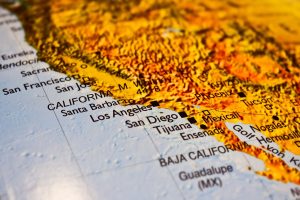 By: Timothy E. Kelley, President and CEO of Imperial Valley Economic Development Corporation (IVEDC)
By: Timothy E. Kelley, President and CEO of Imperial Valley Economic Development Corporation (IVEDC)
As I travel around the world, I’m reminded of the uniqueness of the CaliBaja Binational Mega Regions. Every community tries to market itself as the next ‘big thing’ or ‘one of a kind,’ but the State of California and Baja California form the most diverse and distinctive region I’ve ever visited.
Though relatively unknown or misunderstood, CaliBaja can’t be defined by numbers alone, but by being present, watching the world revolve around you, and seeing it come to you. Our coastal regions may be more expensive, yet they serve as testbeds for high-tech and clean-tech industries that are thriving and drawing global interest. From inland to the east of the region, lower-cost manufacturing, energy, and agriculture are globally competitive and, in many cases, world-leading. Within an area roughly 100 miles by 100 miles, you’ll find a diversity of people and economic activity that rivals most countries or many counties combined.
Given that this large, diverse region spans two countries and multiple counties and municipalities, you might think it would be hard to navigate economically and socially. That’s not the case in CaliBaja. Relatives, neighbors, and businesses recognize no boundaries, jurisdictions, or barriers. We just get it done.
In most regions across the country, companies may choose to expand to another state. In the CaliBaja region, companies can move to a different county or cross the border, where unique international opportunities exist for U.S. companies moving south and Mexican companies moving north. But it isn’t only U.S. or Mexican companies—CaliBaja is a diverse international region with firms from Asia, Europe, South America, and beyond. The more we market the region, the more we see additional investment from across the globe. Baja California has had one of its best years ever in foreign direct investment, and the established Foreign-Trade Zones in Imperial County and San Diego provide a cost-elimination strategy during a time of uncertain tariff policies.
 Economic development experts in the region know the CaliBaja region is a highly attractive place to do business—but telling ourselves how great we are isn’t enough. We must take the show on the road, and we do. A contingent from CaliBaja will soon travel to Mexico City, followed by a trip to Washington, D.C., to promote the legislative fixes needed to strengthen our border region. Priorities include port-of-entry infrastructure investment, adequate staffing to process freight and people efficiently, support from financial institutions such as the North American Development Bank and EXIM Bank, expanded export assistance, and simplified Foreign-Trade Zone procedures—not to mention environmental improvements that benefit both sides of the border.
Economic development experts in the region know the CaliBaja region is a highly attractive place to do business—but telling ourselves how great we are isn’t enough. We must take the show on the road, and we do. A contingent from CaliBaja will soon travel to Mexico City, followed by a trip to Washington, D.C., to promote the legislative fixes needed to strengthen our border region. Priorities include port-of-entry infrastructure investment, adequate staffing to process freight and people efficiently, support from financial institutions such as the North American Development Bank and EXIM Bank, expanded export assistance, and simplified Foreign-Trade Zone procedures—not to mention environmental improvements that benefit both sides of the border.
In CaliBaja, we value our unique situation, built over many years of cross-community collaboration. Now more than ever, the world is discovering our value proposition; investors are not only visiting our region but they’re choosing to call it home.
Throughout the CaliBaja Binational Mega Region, industrial parks have emerged as thriving hubs for binational manufacturing and trade. These parks are not only home to manufacturing plants and warehousing but also to a wide range of service industries that support cross-border operations—freight forwarders, customs brokers, FTZ operators, and logistics providers. Alongside them, commercial centers, hospitality venues, and business services have developed to support this growing ecosystem.
On the Mexican side, the shelter program has created a soft landing for international companies not yet ready for a full-scale operation. Meanwhile, schools with international emphasis have established strong linkage programs—from middle school to full employment—designed to serve the industries operating on both sides of the border.
Academic institutions such as SDSU, CETYS, UABC, UCSD, Imperial Valley College, and USD all have international programs catering to students from both nations, preparing the next generation of binational professionals who will continue to shape the CaliBaja region’s growth and global influence.


